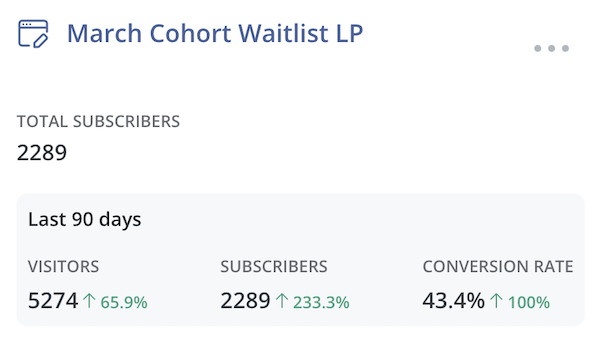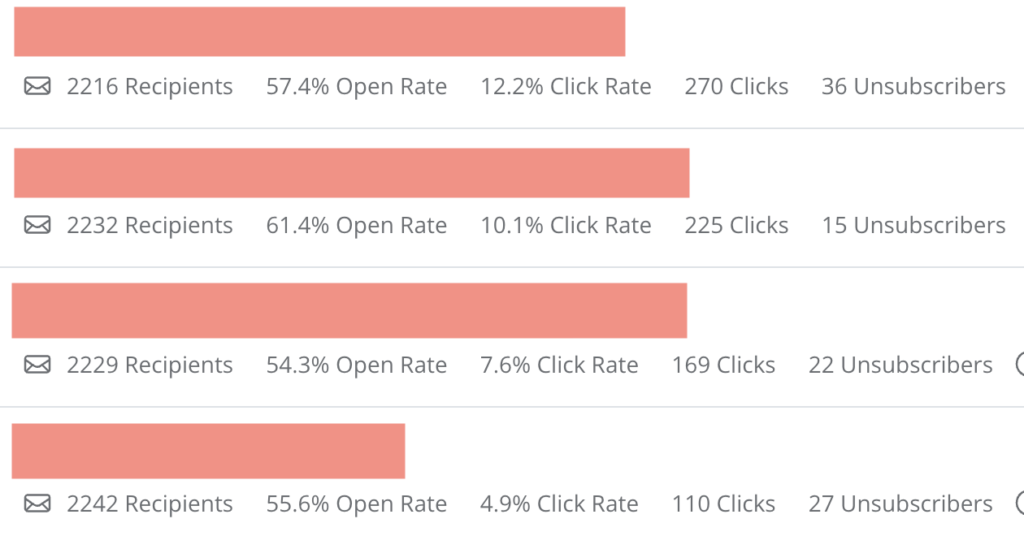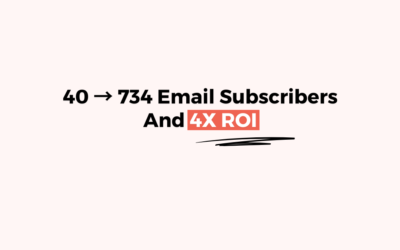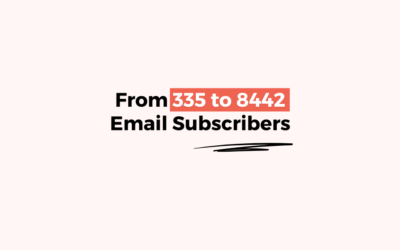Do you want to do multi-5 or 6-figure launches?
So did our client.
Except there was a problem.
Their entire audience was on social media and they were stuck on ~300 email subscribers for weeks.
They understood how fickle the social media algorithms can be and it was wise to move fast. They wanted to move their audience from their socials to their email list.
And this is when they reached out to us last year.
Our only goal at that time?
Pure subscriber growth, no selling.
We took charge and grew it to 8442 subscribers in 3 months.
(You can read the whole case study here)
After that, our goal was to gear up to launch a high-ticket cohort-based programme.
We aimed to sell out the launch in multi-5 or 6 figures… and we closed the launch at $77,300 in total revenue, filling all 32 available spots.
This is the breakdown of the entire strategy we used to achieve that. This took around 2.5 months of work.
(Please pay close attention, as the money is in the details.)
Contents
The Goal
The last launch they did by themselves was ~ $42K.
This time,
Target revenue = $60,800 – $108,800
The cost of the programme = $1900/$3400
Total slots = 32 (4 groups of 8)
$1900 is for the group programme, and $3400 is an upsell for the group programme + 1:1 help.
So, we hypothesised that if everybody took the group programme without the upsell, the revenue would be $1900 X 32 = $60,800.
If everybody took the upsell as well, the revenue would be $3400 X 32 = $108,800.
But that’s not what happens. Some prefer the first, and some prefer the second. So the revenue could be anywhere between those numbers.
And that’s what happened because 21 people took the $1,900 package and 11 took the $3,400 package.
(We just took the best and worst-case scenarios into consideration.)
Now, here’s the step-by-step breakdown:
Step 1 – The waitlist
The doors to the programme were to open on the 20th March, 24… so we opened the doors to the waitlist on the 21st Feb i.e. Wednesday.
The reason we chose Wednesday for the launch is to avoid the inbox rush that subscribers usually face at the start of the week.
The waitlist signup page was open to both current subscribers and new subscribers who wanted to join the waitlist from social media but we didn’t promote it too much on social media.
So, we had ~ 2200 waitlist members to begin with.

Once they signed up for the waitlist, they were sent to a thank-you page.
Step 2 – The Thank-you Page
This is where some magic happened. This page did two things:
- Thank them for showing interest in the programme
- Ask them to take a quick survey (with only 3 questions), as it will help us include what they share in the programme
The questions were based on:
- Their current journey (4 options)
- Their current #1 struggle (4 options)
- What does the programme need to deliver for them to recommend it to their best friend? (Open text)
This survey was a key part of the strategy. Why?
- It takes advantage of the IKEA effect. Since the subscribers are contributing to the programme, they’d place a high value on it and are more likely to purchase
- It segments the subscribers based on their responses to personalise the launch sequence (covering it in step 4)
- It gives you voice-of-customer data to use in emails
As I said, the survey was a key part of the strategy.
Around 74% (1692) subscribers took the survey. These are the people who answered at least the first two questions. Only 379 people answered the third question.
So, the people who took the survey got segmented accordingly and those who did not take the survey were added to a general segment.
(The best strategies have contingencies in place.)
Step 3 – The Pre-selling
One of the biggest mistakes people make when launching anything?
They ask people to join their waitlist and that’s it. They just introduce the offer on the launch day.
Here’s how we avoided it:
Our goal was to make sure the waitlisters were already sold before the offer was even introduced.
For this, we used 4 emails because there’s a gap of 4 weeks between the waitlist opening and the launch.

These 4 emails were sent just like newsletters to the waitlisters. (The people who are on the regular list and not the waitlist received regular newsletters during this time.)
These 4 emails were strategically crafted narratives that implanted the seeds of “I want to work with this person” and “They can really help me”.
These 4 emails were:
1) Email 1: Client’s journey that led to the creation of the programme
2) Email 2: Subscribers’ current #1 struggle (which they filled on the thank-you page survey while signing up for the waitlist), how the client has helped others before with the same struggle, and how the programme will help them
3) Email 3: Vision-Barrier-Breakthrough (VBB) Email:
- Vision: What aspirational vision will resonate with the reader?
- Barrier: What barriers are stopping the reader from achieving this vision?
- Breakthrough: How does the programme act as a breakthrough for these barriers?
4) Email 4: Everything about the programme
It was all about positioning the client as the perfect person to help the waitlisters and bringing them to this conclusion by themselves.
But there was a problem.
Not everybody was going to join the waitlist in the first week. Some were to join in the second. Or fourth. So naturally, they’d miss the previous pre-selling emails.
How did we fix this?
Including an archive link to the previous emails in every email, saying that this is a series and that they should check it out.
Not everybody was going to read them all, but a lot of them did (look at the click-through rates above), and that’s what we wanted.
Step 4 – The Launch Sequence
Now, the biggg stuff.
The doors opened on 20th March and the cohort was to kick off on 3rd April. For these 14 days, we planned a 7-part launch sequence.
Email 1: The one sentence + one link email
Email 2 (after 3 days): The journey email
This email was crafted based on where the subscribers currently are based on their journey and where they will be after taking the cohort.
There were 5 versions of this email. One for each of the four segments (Those who answered the first question on the thank-you page), and one general email for those who didn’t answer anything.
Email 3 (after 3 days): The #1 struggle email
This email was crafted based on what’s the subscriber’s current #1 struggle and how the cohort will help them get past it.
This was pretty similar to email #2 in the pre-launch series, just with a different angle and more social proof.
Again, there were 5 versions of this email. One for each of the four segments (Those who answered the second question on the thank-you page), and one general email for those who didn’t answer anything.
Email 4 (after 3 days): The social proof email
Email 5 (after 2 days): Objection email
Email 6 (after 1 day): Limited spots left email
Email 7 (after 1 day): Final call email
We planned that if the 32 slots get filled at any point during the launch, then the next emails are not sent.
And that’s what happened.
All 32 spots were filled the next day after that 4th email was sent.
As you can see… our strategy is not about constantly bombarding the subscribers with daily emails about “buy my stuff”. Only the last emails were to be sent in a row. (That too if the spots were left)
Step 5 – The Post-launch Email
Four days after the last launch email, all waitlisters (those who didn’t purchase) were sent a thank-you email.
(This one was super important)
This email did two things:
- Thank them for their interest and support
- Ask them for their feedback about what stopped them from joining the cohort
Nearly 60% of objections were about the price and in different words, around 10-15% said they didn’t think our client could SPECIFICALLY help in their case.
Tech Stack For the Entire Strategy
These are the tools that we used to execute everything.
→ ConvertKit: The email marketing tool
→ Divi: For the wailist landing, sales, and thank-you page
→ Formaloo: The thank-you page survey
→ Make: To send the survey data to ConvertKit and segment the subscribers
Just One More Thing
We did not offer a CTA to book a call to learn more. We aimed for a direct sale from the sales page. If they had any questions, they could reply to any of the emails.
This is a risky route to take when selling high-ticket, but the client didn’t wanna take a lot of calls.. and since we had the volume (high demand, limited supply) in our favour, we could afford to take that risk.
So yeah, you have all the information now. Use it to your advantage.
And if you’d like our help in planning, executing, and getting the most $$ out of your next launch, book a free consultation here and let’s have a chat.




0 Comments